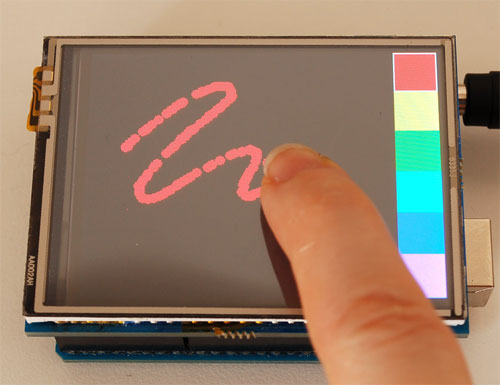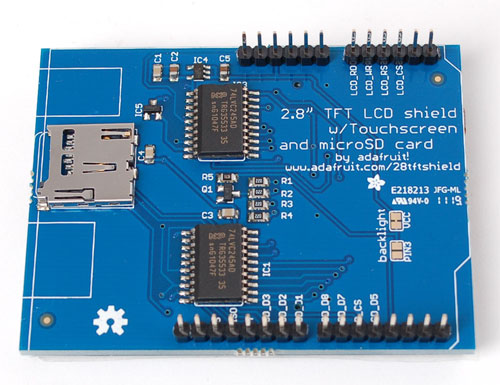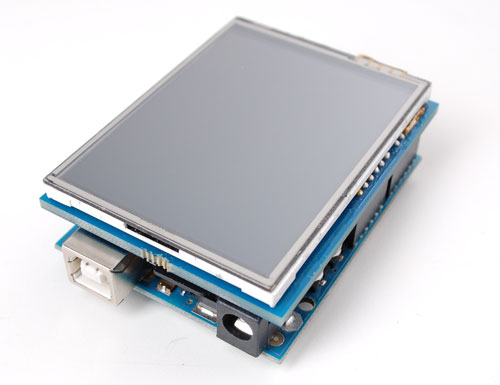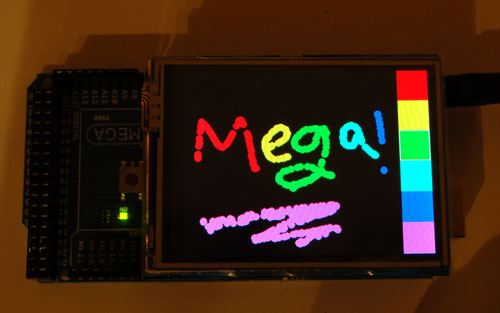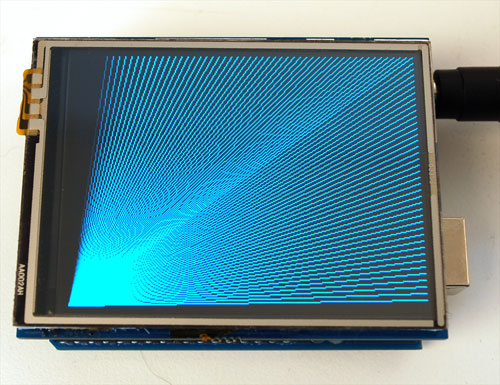Différences entre versions de « Ecran tactile 2.8" TFT »
| Ligne 92 : | Ligne 92 : | ||
Now start up the tftpaint_shield example in the TFTLCD library. The right hand side will have 'color boxes' you can press to select which color you want to draw with. If you press the area to the left where the screen ends, it will erase the screen. | Now start up the tftpaint_shield example in the TFTLCD library. The right hand side will have 'color boxes' you can press to select which color you want to draw with. If you press the area to the left where the screen ends, it will erase the screen. | ||
| − | The touch screen is made of a thin glass sheet, and its '''very fragile''' - a small crack or break will make the entire touch screen unusable. Don't drop or roughly handle the TFT and be especially careful of the corners and edges. | + | {{tmbox |
| + | | type = speedy | ||
| + | | text = The touch screen is made of a thin glass sheet, and its '''very fragile''' - a small crack or break will make the entire touch screen unusable. Don't drop or roughly handle the TFT and be especially careful of the corners and edges. | ||
When pressing on the touchscreen, sometimes people can use the tip of their fingers, or a fingernail. If you don't find the touchscreen responds well to your fingers, you can use a rounded stylus which will certainly work. '''Do not press harder and harder until the screen cracks'''! | When pressing on the touchscreen, sometimes people can use the tip of their fingers, or a fingernail. If you don't find the touchscreen responds well to your fingers, you can use a rounded stylus which will certainly work. '''Do not press harder and harder until the screen cracks'''! | ||
| + | }} | ||
== Références == | == Références == | ||
Version du 12 juin 2012 à 06:32
|
|
En cours de traduction |
Présentation
Quel magnifique produit que le "2.8" TFT touch screen shield" d'AdaFuit
Spice up your Arduino project with a beautiful large touchscreen display shield with built in microSD card connection. This TFT display is big (2.8" diagonal) bright (4 white-LED backlight) and colorful (18-bit 262,000 different shades)! 240x320 pixels with individual pixel control. It has way more resolution than a black and white 128x64 display. As a bonus, this display has a resistive touchscreen attached to it already, so you can detect finger presses anywhere on the screen.
The shield is fully assembled, tested and ready to go. No wiring, no soldering! Simply plug it in and load up our library - you'll have it running in under 10 minutes!
This display shield has a controller built into it with RAM buffering, so that almost no work is done by the microcontroller. The shield does require a lot of pins: 12 lines total for the display, 13 total if you use the microSD card
Of course, we wouldn't just leave you with a datasheet and a "good luck!" - we've written a full open source graphics library that can draw pixels, lines, rectangles, circles and text. We also have a touch screen library that detects x, y and z (pressure) and example code to demonstrate all of it. The code is written for Arduino but can be easily ported to your favorite microcontroller!
Si vous voulez acheter cet article, il est disponible chez MC Hobby.
Caractéristiques
- Affichage LCD de 2.8" de diagonale (TFT)
- Résolution de 240x320 points, couleurs 18-bits (262.000 couleurs)
- Contrôleur ILI9325 (fiche technique - datasheet) ou ILI9328 (fiche technique - datasheet) incluant une mémoire vidéo tampon (RAM)
- Interface digital 8 bits, plus 4 lignes de contrôle.
- Utilise les broches/pins digitales de 5 à 13 et analogique de 0 à 3.
- Ce qui signifie que vous pouvez utiliser les broches/pins digitales 2, 3 et analogique 4 et 5. La broche 12 est disponible si vous n'utilisez pas la carte microSD
- Fonctionne avec un Arduino '328 (Mega pas encore supporté)
- 5V compatible! Commandable avec une logique 3.3V ou 5V
- Régulateur LDO 3.3V - 300mA intégré (Low-Drop Out = à faibles pertes).
- Rétro éclairage à 4 LEDs blanches. Actif par défaut mais vous pouvez connecter un transistor sur la pin digitale pour contrôler le rétroéclairage.
- Ecran résistif 4-fils
FAQ: Foire Aux Questions
Pourquoi utiliser l'interface parallèle?
I was just looking through the datasheet and I notice there is an SPI interface available. Why do you use the parallel interface? SPI would be better fewer pins! Even though the display driver supports SPI, we have not found any displays that could use it - the pins are simply not available on the display connector. Also, SPI would be incredibly, frustratingly slow for such a large screen. If you need an SPI display, AdaFruit propose également check out many of our other offerings, nearly all support SPI-like protocols!.
Comment accéder au broches libres?
All the pins are used! How can I connect anything to the Arduino??
We suggest using a protoshield (with stacking headers) or a proto-screwshield to access the unused pins (2, 3, and analog 4 and 5). You can connect various i2c sensors or analog sensors to analog 4&5. You can also connect an i2c port expander to get more I/O pins. If you desperately need more pins, and you're careful, you can use the 8 datapins while the TFT isn't being written to - they are high-z and unused as long as the WR and RD pins are high
Démarrer sans assemblage
Ce shield est vraiment facile à utiliser. Il n'y a qu'a le raccorder et c'est parti.
Because the TFT is exactly the same size as an Arduino, we preassemble the shield in the factory. To use, simply place it onto your Arduino. No wiring, no soldering!
Test du LCD
We have a library with example code ready to go for use with these TFTs. The library is not incredibly fast and optimized but its a good start and can easily be ported to other micrcontrollers. However, we'll assume you're using an Arduino
Visit our github repository and click on the Downloads button in the top right corner to download a zip of the library and examples. Uncompress the folder and rename it TFTLCD make sure that inside that folder is the cpp and .h files. Then copy it to your arduinosketchfolder/libraries folder. See our tutorial for more details.
You will also need to get the GFX graphics core and click on the Downloads button in the top right corner to download a zip of the library and examples. Uncompress the folder and rename it Adafruit_GFX make sure that inside that folder is the cpp and .h files. Then copy it to your arduinosketchfolder/libraries folder.
|
|
For this shield, there is one more step! Open up the TFTLCD.h file in the libraries folder and uncomment the line at the top that says: |
//comment or uncomment the next line for special pinout! #define USE_ADAFRUIT_SHIELD_PINOUT
Restart the Arduino software. You should see a new example folder called TFTLCD and inside, an example called graphicstest. Upload that sketch to your Arduino. You should see a collection of graphical tests draw out on the TFT
Librairie Adafruit GFX
The TFT LCD library is based off of the Adaftui GFX graphics core library. GFX has many ready to go functions that should help you start out with your project. Its not exhaustive and we'll try to update it if we find a really useful function. Right now it supports pixels, lines, rectangles, circles, round-rects, triangles and printing text as well as rotation.
Check out the GFX tutorial for detailed information about what is supported and how to use it!
DODO: A TRADUIRE tutorial
Exemple: le Paint tactile
The LCD has a 2.8" 4-wire resistive touch screen glued onto it. You can use this for detecing finger-presses, stylus', etc. You'll need 4 pins to talk to the touch panel but we reuse some of the pins for the TFT LCD! This is because the resistance of the panel is high enough that it doesn't interfere with the digital input/output and we can query the panel in between TFT accesses, when the pins are not being used.
Visit our github repository and click on the Downloads button in the top right corner to download a zip of the library and examples. Uncompress the folder and rename it TouchScreen make sure that inside that folder is the cpp and .h files. Then copy it to your arduinosketchfolder/libraries folder. See our tutorial for more details.
DODO: A TRADUIRE tutorial
We connect the 4 pins as follows:
- Y+ is connected to Analog 1
- Y- is connected to Digital 7
- X+ is connected to Digital 6
- X- is connected to Analog 2
Now start up the tftpaint_shield example in the TFTLCD library. The right hand side will have 'color boxes' you can press to select which color you want to draw with. If you press the area to the left where the screen ends, it will erase the screen.
|
|
The touch screen is made of a thin glass sheet, and its very fragile - a small crack or break will make the entire touch screen unusable. Don't drop or roughly handle the TFT and be especially careful of the corners and edges. When pressing on the touchscreen, sometimes people can use the tip of their fingers, or a fingernail. If you don't find the touchscreen responds well to your fingers, you can use a rounded stylus which will certainly work. Do not press harder and harder until the screen cracks! |
Références
- Source: cet Article.
Où Acheter
L’Écran tactile 2.8" TFT est disponible chez MC Hobby.
Toute référence, mention ou extrait de cette traduction doit être explicitement accompagné du texte suivant : « Traduction par MCHobby (www.MCHobby.be) - Vente de kit et composants » avec un lien vers la source (donc cette page) et ce quelque soit le média utilisé.
L'utilisation commercial de la traduction (texte) et/ou réalisation, même partielle, pourrait être soumis à redevance. Dans tous les cas de figures, vous devez également obtenir l'accord du(des) détenteur initial des droits. Celui de MC Hobby s'arrêtant au travail de traduction proprement dit.
Traduit avec l'autorisation d'AdaFruit Industries - Translated with the permission from Adafruit Industries - www.adafruit.com
